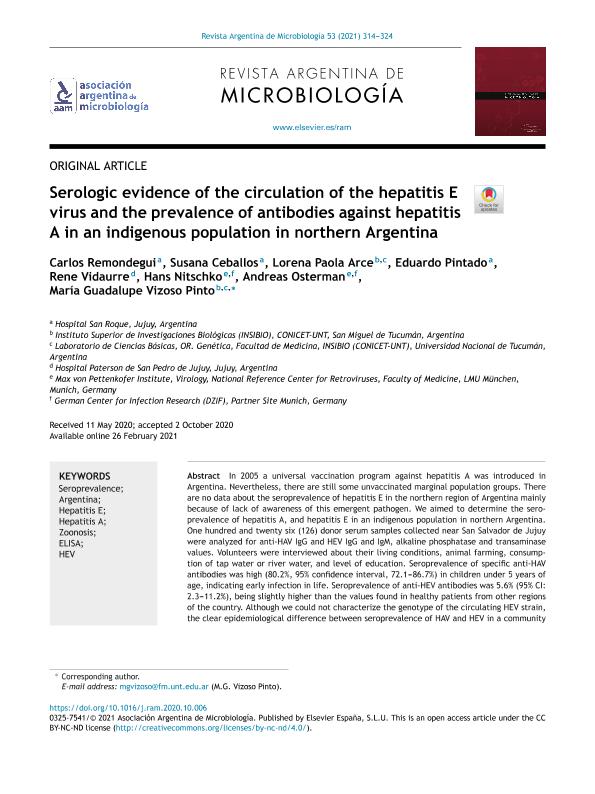Mostrar el registro sencillo del ítem
dc.contributor.author
Remondegui, Carlos
dc.contributor.author
Ceballos, Susana
dc.contributor.author
Arce, Lorena Paola

dc.contributor.author
Pintado, Eduardo
dc.contributor.author
Vidaurre, Rene
dc.contributor.author
Nitschko, Hans
dc.contributor.author
Osterman, Andreas
dc.contributor.author
Vizoso Pinto, María Guadalupe

dc.date.available
2023-01-11T17:43:54Z
dc.date.issued
2021-10
dc.identifier.citation
Remondegui, Carlos; Ceballos, Susana; Arce, Lorena Paola; Pintado, Eduardo; Vidaurre, Rene; et al.; Serologic evidence of the circulation of the hepatitis E virus and the prevalence of antibodies against hepatitis A in an indigenous population in northern Argentina; Asociación Argentina de Microbiología; Revista Argentina de Microbiología; 53; 4; 10-2021; 314-324
dc.identifier.issn
0325-7541
dc.identifier.uri
http://hdl.handle.net/11336/184393
dc.description.abstract
In 2005 a universal vaccination program against hepatitis A was introduced in Argentina. Nevertheless, there are still some unvaccinated marginal population groups. There are no data about the seroprevalence of hepatitis E in the northern region of Argentina mainly because of lack of awareness of this emergent pathogen. We aimed to determine the seroprevalence of hepatitis A, and hepatitis E in an indigenous population in northern Argentina. One hundred and twenty six (126) donor serum samples collected near San Salvador de Jujuy were analyzed for anti-HAV IgG and HEV IgG and IgM, alkaline phosphatase and transaminase values. Volunteers were interviewed about their living conditions, animal farming, consumption of tap water or river water, and level of education. Seroprevalence of specific anti-HAV antibodies was high (80.2%, 95% confidence interval, 72.1–86.7%) in children under 5 years of age, indicating early infection in life. Seroprevalence of anti-HEV antibodies was 5.6% (95% CI: 2.3–11.2%), being slightly higher than the values found in healthy patients from other regions of the country. Although we could not characterize the genotype of the circulating HEV strain, the clear epidemiological difference between seroprevalence of HAV and HEV in a community with poor sanitary conditions suggest that the circulating HEV strains spread through a different transmission route than HAV. Furthermore a significant correlation between anti-HEV IgG and swine farming was found (p < 0.05), which supports a zoonotic transmission path. We reassessed the epidemiological pattern of HAV infection and reported evidence of HEV infection for the first-time in a community belonging to the Guarani ethnic group, highlighting the need to include hepatitis E testing in routine diagnostics in the region.
dc.description.abstract
En 2005 se inició un programa de vacunación universal contra la hepatitis A en Argentina, pero todavía existen algunas poblaciones marginales no vacunadas. Además, los datos sobre la circulación de hepatitis E en el noroeste argentino son escasos. El objetivo de este trabajo fue determinar la seroprevalencia de la hepatitis A y la hepatitis E en una población autóctona del norte de Argentina. Se colectaron y analizaron 126 muestras de suero en habitantes de las yungas jujeñas; se determinaron transaminasas, fosfatasa alcalina y anticuerpos contra los virus de hepatitis A (HAV) (IgG) y hepatitis E (HEV) (IgG e IgM). Se obtuvieron los consentimientos informados y los voluntarios fueron entrevistados para identificar posibles factores de riesgo, como las condiciones de vida y la cría de animales, entre otros. La seroprevalencia de anticuerpos específicos anti-HAV fue alta (80,2%; intervalo de confianza [IC] 95%: 72,1-86,7%) en niños menores de 5 años, lo que indica infección temprana. La seroprevalencia de anticuerpos anti-HEV fue del 5,6% (IC 95%: 2,3-11,2%), ligeramente más alta que en otras regiones del país en pacientes sanos. Aunque no se caracterizó el genotipo circulante del HEV, la clara diferencia epidemiológica entre la seroprevalencia de ambos virus en una comunidad con malas condiciones sanitarias sugiere que la cepa circulante de HEV se transmite por una vía diferente que la del HAV. Además, encontramos una significativa correlación entre la cría de cerdo y la presencia de anticuerpos IgG anti-HEV (p < 0,05), lo que sugiere una vía de transmisión zoonótica. Reevaluamos el patrón epidemiológico de infección por el HAV y aportamos por primera vez una evidencia de infección por el HEV en una comunidad que pertenece a la etnia guaraní, por lo que destacamos la necesidad de incluir la detección de hepatitis E en la región.
dc.format
application/pdf
dc.language.iso
eng
dc.publisher
Asociación Argentina de Microbiología

dc.rights
info:eu-repo/semantics/openAccess
dc.rights.uri
https://creativecommons.org/licenses/by-nc-nd/2.5/ar/
dc.subject
ARGENTINA
dc.subject
ELISA
dc.subject
HEPATITIS A
dc.subject
HEPATITIS E
dc.subject
HEV
dc.subject
SEROPREVALENCE
dc.subject
ZOONOSIS
dc.subject.classification
Enfermedades Infecciosas

dc.subject.classification
Ciencias de la Salud

dc.subject.classification
CIENCIAS MÉDICAS Y DE LA SALUD

dc.title
Serologic evidence of the circulation of the hepatitis E virus and the prevalence of antibodies against hepatitis A in an indigenous population in northern Argentina
dc.title
Evidencia serológica de la circulación del virus de la hepatitis E y prevalencia de anticuerpos contra la hepatitis A en una población indígena en el norte argentino
dc.type
info:eu-repo/semantics/article
dc.type
info:ar-repo/semantics/artículo
dc.type
info:eu-repo/semantics/publishedVersion
dc.date.updated
2021-04-28T21:00:25Z
dc.identifier.eissn
1851-7617
dc.journal.volume
53
dc.journal.number
4
dc.journal.pagination
314-324
dc.journal.pais
Argentina

dc.journal.ciudad
Ciudad Autónoma de Buenos Aires
dc.description.fil
Fil: Remondegui, Carlos. Hospital Zonal General Agudos San Roque; Argentina
dc.description.fil
Fil: Ceballos, Susana. Hospital Zonal General Agudos San Roque; Argentina
dc.description.fil
Fil: Arce, Lorena Paola. Consejo Nacional de Investigaciones Científicas y Técnicas. Centro Científico Tecnológico Conicet - Tucumán. Instituto Superior de Investigaciones Biológicas. Universidad Nacional de Tucumán. Instituto Superior de Investigaciones Biológicas; Argentina. Universidad Nacional de Tucumán. Facultad de Medicina; Argentina
dc.description.fil
Fil: Pintado, Eduardo. Hospital Zonal General Agudos San Roque; Argentina
dc.description.fil
Fil: Vidaurre, Rene. Hospital Paterson de San Pedro de Jujuy; Argentina
dc.description.fil
Fil: Nitschko, Hans. Ludwig Maximilians Universitat. Max Von Pettenkofer Institute; Alemania. German Center for Infection Research; Alemania
dc.description.fil
Fil: Osterman, Andreas. German Center for Infection Research; Alemania. Ludwig Maximilians Universitat. Max Von Pettenkofer Institute; Alemania
dc.description.fil
Fil: Vizoso Pinto, María Guadalupe. Consejo Nacional de Investigaciones Científicas y Técnicas. Centro Científico Tecnológico Conicet - Tucumán. Instituto Superior de Investigaciones Biológicas. Universidad Nacional de Tucumán. Instituto Superior de Investigaciones Biológicas; Argentina. Universidad Nacional de Tucumán. Facultad de Medicina; Argentina
dc.journal.title
Revista Argentina de Microbiología

dc.relation.alternativeid
info:eu-repo/semantics/altIdentifier/doi/https://doi.org/10.1016/j.ram.2020.10.006
dc.relation.alternativeid
info:eu-repo/semantics/altIdentifier/url/https://www.sciencedirect.com/science/article/pii/S0325754121000122
Archivos asociados
